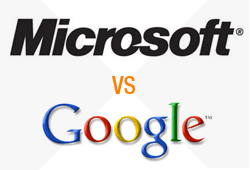A recent Computerworld article by Patrick Thibodeau looks into Gmail’s leaps into the Enterprise email market which Microsoft has monopolized for well over a decade. Thibodeau leads the article by acknowledging that Google’s Enterprise reach is still minuscule in comparison to Microsoft’s:
Google’s share of the enterprise email market currently “hovers” at around 1%, but it will reach 10% within a few years, research firm Gartner predicts. Google is gaining ground with enterprises that have 5,000 or more seats, Gartner said, naming several public- and private-sector users with more than 10,000 Gmail seats.
Continuing to discuss the recent progression of the battle for Cloud-based Enterprise services—and Microsoft’s lagging in that race—Thibodeau acknowledges that Microsoft is making progress with it’s cloud-based service offerings. And Microsoft seems to be making bold steps toward making cloud-based offerings a priority over its longer-standing “brick & mortar” solutions.
Microsoft’s answer to Google’s upgrade pace “is that it intends to add functionality to Exchange in the cloud before adding it to the on-premises version,” [Gartner analyst Matthew] Cain wrote. “This represents a major shift for Microsoft, and its actual execution has yet to be demonstrated.”
It will be interesting to see how Microsoft’s veteran Enterprise clientele respond to getting product updates later than adopters of Microsoft’s newest cloud offering.
An ironic jab at Google ensues later in the article, where the analyst knocks Google’s inability to deliver product updates on schedule:
Cain, in his report, cited a number of things Google has to do to win more enterprise businesses. Among other things, he said the company must deliver new features on schedule. Another obstacle for Google is a lack of transparency, which is a problem affecting the cloud in general, he said.
It seems a bit of a stretch to knock Google for failure to deliver product updates on schedule when Microsoft too has it’s own problems addressing product development needs in a timeline suitable for the end-user—an issue we discussed in a past article about Microsoft’s struggling IE numbers.
Nevertheless, Google has much work to do in order to chip away at the still monstrous market share that Microsoft enjoys in the Enterprise. Either way, the resulting battle will undoubtedly bring faster and more robust tools to companies using the products of either software giant.
FYI: OPUSfidelis enjoys use of Google’s Apps for Business, a great fit for our web-focused service offerings and the distributed teams we work with.


